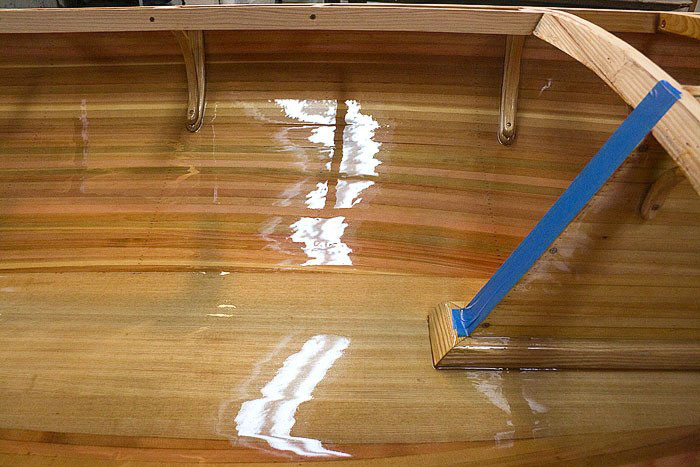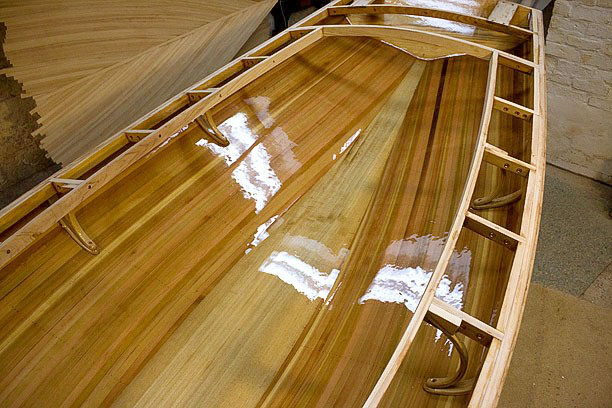North interior, varnished with Le Tonkinois.
Once the knees cured on North, the interior could be sanded and prepped, followed the next day with the Le Tonkinois tung oil varnish. Without Emily’s help it took me all day, but it looks great.
I continue to be impressed with Le Tonk. When going on over bare wood, you don’t have to sand between coats until a gloss film builds on the surface. But going on over epoxy every coat is a high gloss, and does require a light scuffing between coats. Otherwise the surface is so slick that the wet coat pulls away with it’s own surface tension and “orange peels.” Not a big deal to scuff between coats, but not quite as easy as advertised. Still far easier to use than varnish.
I have since found a few more sources of information, and at least a two or three people report great results in terms of long term protection. One UK magazine did a multi-year test of about a dozen different varnish products, and Le Tonk rated second overall. One advantage for the average boat owner appears to be that it decays steadily from the surface like skin, slowly wearing away while gradually losing it’s gloss. Though the surface needs a refresher coat to keep looking good, the existing layers still provide protection from the elements. This is quite different from traditional varnish, which is harder and stays shiny longer, but fails catastrophically if left unattended by cracking and peeling all the way down to the wood, letting in water and sunlight decay. Once that happens, restoring the original appearance of traditional varnish requires sanding off the old finish completely and starting over. So, at this point I’m feeling a little more at ease about giving this stuff a try.
One other thing I’ve noticed is the color tempers a bit after a few days of curing. While it’s wet the color enhancing of the wood is rather dramatic and a little warm, but it settles down to something more tame in a few days.
While waiting for everything to set up, there was time to oil the oar handles. Varnish on handles give you blisters, apparently, but a light oil helps keep the handles from wicking up water and splitting.
I used a 50/50 mix of Linseed Oil and Turpentine, which I promptly spilled. Well, actually, it dissolved the plastic cup I was using. In any case, now the basement smells great. Reminds me of when I was a kid, and my parents went through a period dabbling with painting large canvases in oil paints. The converted garage rec room smelled like Linseed Oil and Turpentine during those years. It was intriguing to watch a painting develop slowly over the course of several months, and I will always associate the smell with watching them work quietly in a kind of nimbus of tranquility on Sunday afternoons. It gives me a little memory rush every time I open the door to the basement now.
melonseed skiff, mellonseed skiff, melon seed, mellon seed





